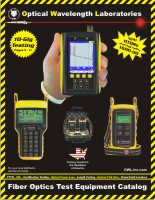| FREQUENTLY ASKED QUESTIONS | |
| OTDRs | Click here to view common questions about OTDRs. |
| Videos | OWL has videos on a myriad of fiber optics related topics which may answer your question. Click here for a list of videos. |
| Call | Contact OWL during business hours at 262-473-0643. |
| Submit a question through our information request form. | |
| Product | Q & A |
|
Fiber OWL Micro OWL WaveTester |
Question:
OWL Reporter
software tells me that no device was found when downloading stored data.
Answer: There is an issue with the connection to the PC COM port. Common causes are:
|
|
Fiber OWL Micro OWL |
Question:
When setting up a Fiber OWL or Micro OWL optical power meter for a certification test, what does the word "LINK" mean?
Answer: A "LINK" is simply a group of fibers that have identical characteristics such as fiber type, fiber length, number of connections and number of splices, along with using the same cabling standard for certification. When moving on to a new fiber cable (i.e. a group of fibers with different characteristics), a new LINK must be created. |
|
Fiber OWL Micro OWL |
Question: How do I store bi-directional results with a Fiber OWL or Micro OWL optical power meter?
Answer: It must first be noted that these power meters can neither store bi-directional test results automatically nor simultaneously. However, since this is the same fiber being tested, you can use the same STORED LINK settings. Being creative when entering fiber names will allow bi-directional test results to be grouped together in OWL Reporter test reports under the same STORED LINK name. For example: let's say a 24-strand fiber cable runs from Closet A to Closet B. The first set of tests could use a fiber label such as A-->B:, and the power meter will append the fiber number 11-24 to the end of the label, resulting in a series of fiber tests such as: A-->B:1 A-->B:2 ... A-->B:23 A-->B:24 Once the testing has been completed in one direction, swap the units and test from the other direction, this time changing the fiber label to denote the new direction, such as B-->A:1 through B-->A:24. Click here to watch a video about naming test results in Fiber OWL and Micro OWL optical power meters. |
|
Fiber OWL Micro OWL WaveTester ZOOM |
Question: How do I display the loss in my fiber link on my meter?
Answer: The Fiber OWL, Micro OWL, WaveTester and ZOOM optical power meters are all capable of displaying the optical loss in a link. Optical loss measurements are always given in dB. A power meter, a light source, and reference cables are required to measure the optical loss in a fiber link. Optical loss measurement is a two step process: setting a reference, and testing the fiber link. To set the reference in the meter, otherwise known as "zeroing", attach the light source to the meter via the reference cable(s). Make sure that the units are powered on, and are set to the same wavelength (e.g. 850nm). You may now set the reference in the meter. Each meter has a different way of setting zero, so consult the manual for instructions. Double check your zero point by setting the meter to dB mode. The number on the display should be approximately 0.00 dB. Once you have set the zero point in the meter, you are now ready to test your fiber link. Disconnect the patch cord from the meter, and take the meter to one end of the link (along with another test cable), and the light source to the other end. Connect the meter and the light source to the fiber being tested. If necessary, set the meter to display units in dB. The resultant number will show the amount of loss in the link as a negative number. Example: We are testing a fiber link at 850nm. When we connect our 850nm light source to the meter, the dBm reading is -20.10. However, since we zeroed out our equipment, the meter will show a reading of approximately 0.00 dB. When we disconnect the patch cord from the meter, take the units to opposite ends of the fiber link, and connect them to the fiber under test, our meter shows -1.24 dB. What this means is that the fiber link is losing 1.24 dB of optical power due to the total loss of the passive components of the fiber link (fiber loss, connector loss, and splice loss). Optical loss can be used for PASS/FAIL readings as well. The actual optical loss number on the meter is compared with the theoretical PASS/FAIL threshold as defined by the chosen cabling standard. A link will PASS when the number on the meter is between zero and the PASS/FAIL number. Likewise, a link will FAIL when the number is lower than the PASS/FAIL number. PLEASE NOTE: once the reference is set in the optical power meter, do not allow the reference cable to be disconnected from the light source port, and in the case of multimode testing, do not allow the cable to begin unwrapping from the mandrel. If the reference cable is disturbed in any way, the reference level will now be different from what the power meter previously recorded as the optical reference, rendering the reference level as invalid. A new reference will have to be re-set, which also means that the fibers must be re-tested from the beginning as well. |


